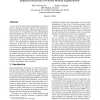Free Online Productivity Tools
i2Speak
i2Symbol
i2OCR
iTex2Img
iWeb2Print
iWeb2Shot
i2Type
iPdf2Split
iPdf2Merge
i2Bopomofo
i2Arabic
i2Style
i2Image
i2PDF
iLatex2Rtf
Sci2ools
CVPR
1997
IEEE
1997
IEEE
Empirical Bayesian EM-based Motion Segmentation
A recent trend in motion-based segmentation has been to rely on statistical procedures derived from ExpectationMaximization (EM) principles. EM-based approaches have various attractives for segmentation, such as proceeding by taking non-greedy soft decisions with regards to the assignment of pixels to regions, or allowing the use of sophisticated priors capable of imposing spatial coherence on the segmentation. A practical difficulty with such priors is, however, the determination of appropriate values for their parameters. In this work, we exploit the fact that the EM framework is itself suited for empirical Bayesian data analysis to develop an algorithm that finds the estimates of the prior parameters which best explain the observed data. Such an approach maintains the Bayesian appeal of incorporating prior beliefs, but requires only a qualitative description of the prior, avoiding the requirement of a quantitative specification of its parameters. This eliminates the need for triala...
Computer Vision | CVPR 1997 | Empirical Bayesian Data | Motion-based Segmentation | Non-greedy Soft Decisions |
| Added | 25 Aug 2010 |
| Updated | 25 Aug 2010 |
| Type | Conference |
| Year | 1997 |
| Where | CVPR |
| Authors | Nuno Vasconcelos, Andrew Lippman |
Comments (0)

